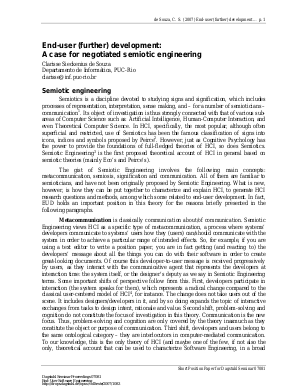End-user (further) development: A case for negotiated semiotic engineering
Author Clarisse de Souza
-
Part of:
Volume:
Dagstuhl Seminar Proceedings, Volume 7081
Part of: Series: Dagstuhl Seminar Proceedings (DagSemProc) - License:
 Creative Commons Attribution 4.0 International license
Creative Commons Attribution 4.0 International license
- Publication Date: 2007-07-02
File

PDF
DagSemProc.07081.10.pdf
- Filesize: 55 kB
- 4 pages
Document Identifiers
Subject Classification
Keywords
- Semiotic engineering
- explanations
- representation codes
Metrics
- Access Statistics
-
Total Accesses (updated on a weekly basis)
0Document
0Metadata
Abstract
Semiotic Engineering views human-computer interaction as a special case of computer-mediated communication. In it, designers communicate to users their design vision about computer artifacts: what they are meant to do and how, but also what benefits they bring to users' lives (as perceived by designers). The semiotic theories of meaning subscribed by Semiotic Engineering postulate that meanings always evolve - there are no fixed meanings. Thus, the meanings users assign to computer artifacts and the meaningful situations in which they expect such artifacts to be valuable evolve. End user development is thus a requirement for "useful artifacts". Users should be able to encode new meanings and meaningfulness in them. However, there are limitations for this encoding: helping designers and users negotiate new meanings at interaction time, through the mediation of systems' interfaces, is thus a key issue for Semiotic Engineering. In this scenario, explanations - especially those about what artifacts cannot do, have not done, and why - are cruacially important.
Cite As Get BibTex
Clarisse de Souza. End-user (further) development: A case for negotiated semiotic engineering. In End-User Software Engineering. Dagstuhl Seminar Proceedings, Volume 7081, pp. 1-4, Schloss Dagstuhl – Leibniz-Zentrum für Informatik (2007)
https://doi.org/10.4230/DagSemProc.07081.10
BibTex
@InProceedings{desouza:DagSemProc.07081.10,
author = {de Souza, Clarisse},
title = {{End-user (further) development: A case for negotiated semiotic engineering}},
booktitle = {End-User Software Engineering},
pages = {1--4},
series = {Dagstuhl Seminar Proceedings (DagSemProc)},
ISSN = {1862-4405},
year = {2007},
volume = {7081},
editor = {Margaret H. Burnett and Gregor Engels and Brad A. Myers and Gregg Rothermel},
publisher = {Schloss Dagstuhl -- Leibniz-Zentrum f{\"u}r Informatik},
address = {Dagstuhl, Germany},
URL = {https://drops.dagstuhl.de/entities/document/10.4230/DagSemProc.07081.10},
URN = {urn:nbn:de:0030-drops-10836},
doi = {10.4230/DagSemProc.07081.10},
annote = {Keywords: Semiotic engineering, explanations, representation codes}
}
